Construction of the Train de l’Est begins
– at 87,000$ per commuter
October 21st, 2010 by ant6n
Last week the AMT started the construction of the first stations of the Train de l’Est, a new commuter rail line linking the downtown of Montreal with Montreal-Nord, the east of the Island, as well as Repentigny and Mascouche off the island. The line goes through the electrified Mont-Royal Tunnel, then along a single-tracked CN right of way until the East of the island, then 12km on a new track in the median of the 640 highway to Mascouche. The first trains are projected to roll in September 2012, probably as far as Pointe-Aux-Trembles or Repentigny. It’s the revival of a shorter all-electrified line, which ceased operation in 1968.
This is a project that the suburbs have been lobbying for for years. And this is the main problem with this project — it is very much oriented just for them. 478 million dollars are spent to move a projected 5500 suburbanites downtown and back – 11000 trips on a weekday on a 53km-long line along a track that mostly exists today. That’s 87,000$ dollars a person – one could buy cars for all passengers at a fraction of the cost. It’s more expensive per rider than the ridiculous 16$ Billion Second Avenue Subway in New York (probably the most expensive transit project ever). Also In comparison, the extension of Montréal’s Orange line into Laval at 745 million dollars brought in 30 thousand new weekeday commuters. That’s 25,000$ per person to blast a completely new subway tunnel under a river, not to add a couple of stations to a mostly existing track.
The issue is not that the project is too expensive, although it should probably be cheaper – it was originally projected at 300 million. The problem is that it’s not designed to get a enough riders, especially on the island. It’s not an effective use of resources, both financial and infrastructure (e.g. rail right of ways).
It’s not that there is no demand. The line passes through the North of Montreal, through the boroughs of Montreal-Nord, Ahuntsic Cartierville, Villeray-Saint-Michel-Parc Extension and Saint-Leonard, which have a total population of 420,000. It intersects and runs parallel to some of Montreal’s most frequented bus lines.
- the 139 (Pie-IX) with 40,000 daily trips,
- the 67 (St-Michel) with 40,000 (in 2008),
- the 121 (Sauvé) with 38,000, and
- the 69 (Gouin) with 27,000.
All these bus lines feed people into the distant metro system to get them downtown. The four lines alone see more than ten times the traffic the train is supposed to get. Earlier this year, Spacing Montreal published an article entitled Montréal-Nord in exile: Public transit and social exclusion, which explores the connection between the troubled areas in the North of Montreal and its public transit woes, and the hope for the new train.
But right now I find it doubtful that many riders will be able to benefit from this train. Sure, it will be faster, but there are very few stations in Montreal Nord – only 2 along a 6.5km stretch (Montreal-North at Pie-IX, Saint-Leonard at Lacordaire), so people have to travel farther to reach a train stop. The trains will only have 5 or 6 departures during rush hour, whereas the buses come at least every 10 minutes. This means you have to plan your daily schedule completely around the train. But you still have to pay a higher fare – almost 50% more for the monthly pass, up to twice regular fare for students. And by the time the trains pass through Montreal-Nord, they are going to be packed, making the trip basically as unpleasant as the bus ride.
The AMT plans to build an “intermodal hub” at Anjou, but are at the same time putting 4223 parking spots along the line, with a provision to add 1322 more – so every projected rider is to arrive by car (I’ve written about the commuter rail’s misguided focus on Park and Ride facilities, they are not “intermodal hubs”). So the focus is not on urban dwellers, many of whom do not own a car, but rather on suburbanites.
And thus the train becomes an extension of the car into downtown, rather than the extension of transit out; it encourages sprawl and perpetuates car-dependent life styles.
But how could the project be expanded to improve service in Monreal?
A possible way to expand this project to improve service to the north of Montreal would be to construct a surface metro, similar to the plan the city already had back in 1981, putting several stations along the badly served, heavily populated, bus-riding neighborhoods around Montreal-Nord.
New, dedicated, electrified double-tracks could be installed up to Papineau, then single tracks to Anjou. With a passing point around Viau, this would allow service as often as every 10 minutes to Anjou. Such a schedule could be accomplished with only 6 or 7 trains, all just running back and forth, totaling around 200 departures a day. If only one single track where built, one could serve Papineau every 20 minutes, or Saint-Leonard (Lacordaire) every 30 minutes, both using only 2 trains.
200 departures a day with 7 trains
Currently the AMT plans to provide 16 departures with 5 trains. In the morning, all trains start at Mascouche and get dumped into Gare Centrale. Only few run back and forth more than once. You need a lot of trains for fairly little service, and you need a lot of space downtown to store those trains during the day. But on the current CN-owned non-electrified freight track you cannot easily provide more service. On one hand, running on diesel is much more expensive than running on electricity; the AMT could not afford to send back nearly empty trains. On the other hand, CN would not allow that much passenger traffic on their freight line.
Note how despite the many extra stations, the travel time could actually be similar to the currently projected ones: electrified trains accelerate much faster than Diesel trains. The new dual mode trains that the AMT will use are almost twice as powerful in electric mode. Modern light-weight electric multiple unit trains like Alstom’s Coradia Nordic (built for Sweden’s Commuter Trains), Siemens Desiro, or Stadler’s FLIRT etc. etc. are even quicker and could easily make the above schedule given good track conditions, and decrease travel time from Montreal-Nord up to 50%. Having many existing train manufacturers also means that they are more affordable due to the competition (unlike the rubber-tyred metro). maybe 10 to 20 million dollars for a whole train carrying a thousand people.
Now the AMT will tell you (and has told me in the past), that this is not their market; that travel within the city should be done by bus or by metro. But given the expense and slowness of metro expansion, and the need to provide more transit in the area, the AMT should really get into the rapid transit game inside the city. The 10 minute service as shown above, together with the diesel operation to Mascouche could easily carry 80,000 trips a day, maybe more, at a cost of 200 to 400 million dollars extra, including rolling stock, if the design is kept lean and functional.
The CEO of the AMT, Joël Gauthier, believes, and he is probably correct, that there will be much more demand than 11000 trips a day. The idea is to put the train into place with 16 departures a day, and expand it if there is more demand – in negotiation with CN. This sounds a bit like “let’s create a crappy service, and if it’s successful, we’ll try to make it better maybe.” Lets hope that at least the current stations are built so that more tracks can easily be added, and maybe one day the surface metro can become a reality.
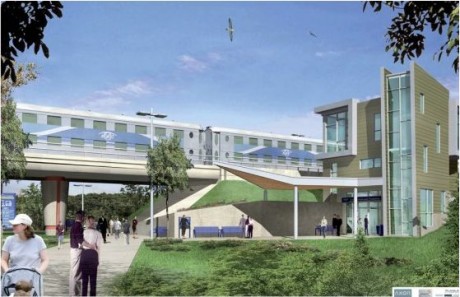
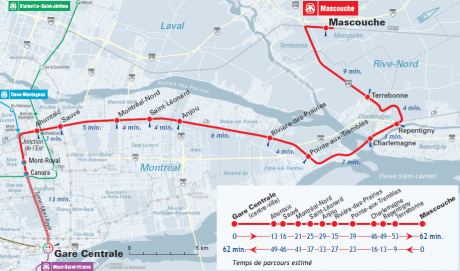
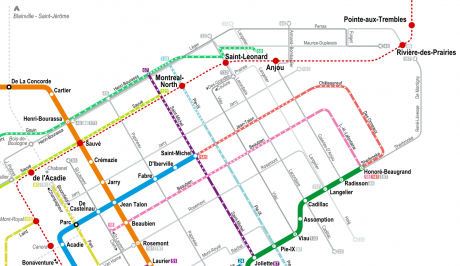
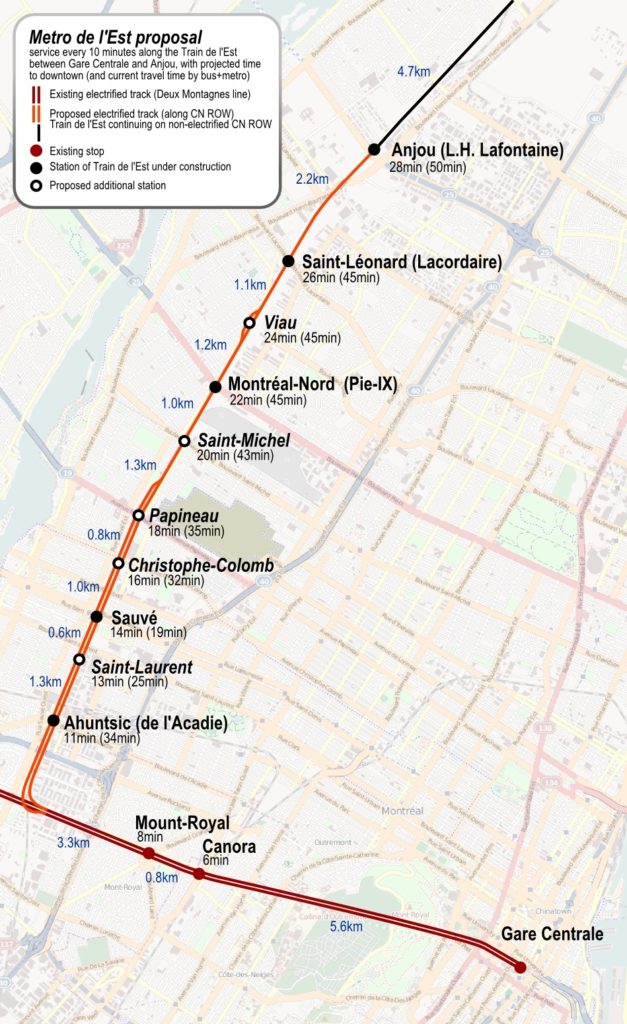
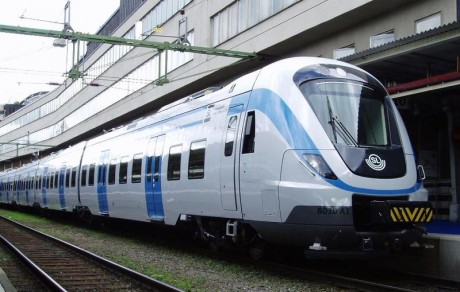
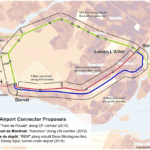
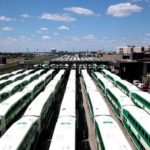
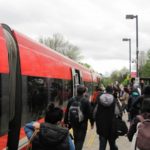
October 23rd, 2010 at 13:55
Excellent post! Yes, the Train de l’Est will attract many more than 11000 commuters. Those 11000 are for just those 18 departures a day. If we expanded it to 40, ridership would scale up accordingly.
I think one of the key problems with the line is the Mascouche-Repentigny segment. This is what is making the project expensive. The AMT feels that it needs to combine ridership from both markets to make the line successful, which is utterly false. The Repentigny branch, as you pointed out, is strikingly urban. It could also be extended east into L’Assomption or possibly Joliette along existing tracks. And the Mascouche branch would benefit from the ridership in Eastern Laval if the line were routed through there on existing tracks.
I agree with you that a few more stations are needed to serve urban markets, which will be huge ridership generators. Perhaps with all the additional departures increased ridership would ensue, we could have express trains serving the suburbs. Stops are definitely needed at Saint-Michel and Viau to intersect frequent bus lines, but that’s all I think. However, we must also count on the STM to offer trainbus services tailored specifically to getting people to the trains. If train ridership in urban areas is weak, it’s because of the STM and not because of poor planning on the part of the AMT. If the STM’s weak train-bus connectivity in the West Island is any indication, we can expect people to have a hard time accessing the train in the east end.
Another thing, we should go back to having STM passes work on Zone 1, and possibly even Zone 2 trains. This would offer the financial incentive we need to assure good urban rail ridership.
October 23rd, 2010 at 16:56
Agreed. I didn’t even get into the suburban portion of this track alignment (the post was getting long). The segment in the Middle of the Highway is both a replication of existing tracks, and an expensive detour. Just from the AMT image (above) one can easily see that the Laval line is much shorter. And in the long term the Laval branch might get developed, which would make this detour a bit useless.
The only advantage I can see is that the AMT is going to own that track, so they don’t have to pay CN or negotiate between freight to use that line.
Re buses: Every rail expansion should come with a bus-feeder concept. Park-and-ride is not enough. I still think new stations should be added at Viau, St Michel (as you pointed out), but also at Papineau. The others are more optional.
I wonder whether the many bad bus-train connections are due to some sort of agency-turf related issues.
October 23rd, 2010 at 22:29
Interesting. Maybe the reason the suburban agencies are more willing to coordinate bus and train is that it is much more financially advantageous for them to do so.
See, the TRAM revenues are divided between all the participating agencies based on ridership. Therefore, agencies make more money selling local passes like the CAM. Now, suburban riders are going to have to get a TRAM anyways so there’s no loss in sending people to the train. In fact, there’s a gain because they’re onboard for a shorter ride but you’re paid by net ridership.
On the other hand, Montrealers who don’t have a good train connection will buy the CAM instead of the TRAM, netting the STM more money. However, if the STM did provide good bus-train connectivity, it would need to carry those passengers a shorter distance which is cheaper. Hopefully, the financial incentive or at least a political incentive is there for the STM to offer good connections in the East End. I don’t think the city of Montreal will be too pleased if their own residents can’t take the train they just paid to build. (The lines in the West Island are 90 and 130 years old, so there is no attachment there)
Construction has only started on the Montreal-Repentigny portion of the line, so there is hope still that the AMT may reverse its decision. I sincerely hope this happens before next year when construction starts on the Mascouche-Repentigny portion.